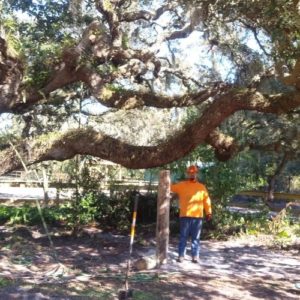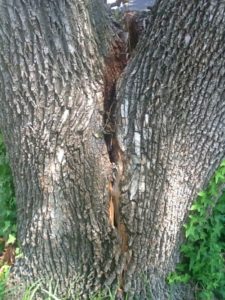Supplemental supports are support systems that reduce risk or failure associated with the tree’s crown or root system. These supports help the tree by reducing movement in the branches and stem of the trees. By applying structures to weak areas of the tree, you can reduce risk or damage to your property and your trees.
Types of Supplemental Supports
- Prop Installations
- Brace Rods
- Cables
When Should Supplemental Supports Be Installed
 Before deciding if your tree needs supplemental support, you should first have your tree examined by your tree care provider or board-certified arborists. The most common risk of tree damage and breakage is a split tree. A split tree is when the trunk of the tree begins to split down the middle creating a “V” in the stem of the tree. Over time, the tension and compression of the branches will cause the tree to crack down the middle resulting in breakage.
Before deciding if your tree needs supplemental support, you should first have your tree examined by your tree care provider or board-certified arborists. The most common risk of tree damage and breakage is a split tree. A split tree is when the trunk of the tree begins to split down the middle creating a “V” in the stem of the tree. Over time, the tension and compression of the branches will cause the tree to crack down the middle resulting in breakage.
Other common risks that require supplemental support are overextended limbs and weakly anchored trees. Overextended limbs can occur when branches grow horizontally or downward with much of the foliage on the ends of the limb.
In this picture, you can see the branch of the tree growing downward. In this picture, the team is placing a brace rod so the tree limb can rest on it reducing tension in the tree’s stem.
Weakly anchored trees can occur when a tree has been incorrectly transported into compacted or shallow soil or when roots have damage and decay.
If you believe your tree needs supplemental support, contact your board-certified arborist today to get a tree assessment.



